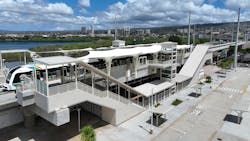Honolulu’s mostly elevated autonomous rail system, Skyline, officially opened for service on June 30. The first phase of the project will shuttle riders along an 11-mile segment and serve nine stations between Kualakaʻi (East Kapolei) Station and Hālawa (Aloha Stadium) Station.
A ceremony to mark the opening of the rail project included speeches from local, state and federal officials, transit stakeholders and residents who have been anticipating the start of service.
“Skyline presents an unprecedented opportunity to connect passengers to our central and leeward cities and the distinct beauty and character they each possess,” said Honolulu Mayor Rick Blangiardi.
The smiles and joy of the project’s opening day were hard won. The project took years of planning, 12 years of construction, incurred delays, cost overruns and leadership turnover and the threat of losing federal funding before a project recovery plan was developed and approved.
In a tweet following his inaugural ride on the system, Mayor Blangiardi added “you cannot overstate the word historic, you cannot overstate the word iconic, you cannot overstate the word transformative.”
To celebrate the opening of Skyline, all transit services will not charge fares through July 4. Customers will need a HOLO card to board transit.
The Honolulu Authority for Rapid Transportation (HART) oversaw construction of the project and transferred control to the city and county of Honolulu in early June 2023. HART will continue working to build the next phases of the project, which includes the Airport Extension planned to open in 2025 that will connect Aloha Stadium with four additional stations to Middle Street – Kalihi Transit Center and the City Center Extension that will open in 2031 and add six stations to Civic Center.
Rail cars
Hitachi Rail responsible for manufacturing the railcars used on Skyline, including the design and construction of the vehicle’s subsystems, testing and commissioning of the entire system prior to revenue service, and the company will operate and maintain Skyline’s core systems.
“We’re delighted to have delivered Honolulu’s largest ever infrastructure project, which will have a major impact reducing congestion and emissions on the island. Reducing car journeys by up to 40,000 a day, once the full system is complete, this will make a huge difference to travel in Hawai’I,” said Hitachi Ltd. Executive Vice President Energy and Mobility Alistair Dormer.
Hitachi Rail explains this is the “first true mass transit GoA4 (Grade of Automation) system” to begin serving riders in the U.S.
“The initial opening of the Honolulu Rail Transit Project is a momentous achievement, and Hitachi Rail has been an instrumental partner in reaching this goal of delivering the first fully automated driverless commuter rail system in the country to the community. The HART Team is extremely grateful to have earned the trust and support from our stakeholders to work collaboratively in the interest of the taxpayer to deliver the first installment of the state’s largest capital improvement project and infrastructure investment in its history,” said HART CEO Lori Kahikina.
About the Author

Mischa Wanek-Libman
Group Editorial Director
Mischa Wanek-Libman is director of communications with Transdev North America. She has more than 20 years of experience working in the transportation industry covering construction projects, engineering challenges, transit and rail operations and best practices.
Wanek-Libman has held top editorial positions at freight rail and public transportation business-to-business publications including as editor-in-chief and editorial director of Mass Transit from 2018-2024. She has been recognized for editorial excellence through her individual work, as well as for collaborative content.
She is an active member of the American Public Transportation Association's Marketing and Communications Committee and served 14 years as a Board Observer on the National Railroad Construction and Maintenance Association (NRC) Board of Directors.
She is a graduate of Drake University in Des Moines, Iowa, where she earned a Bachelor of Arts degree in Journalism and Mass Communication.

